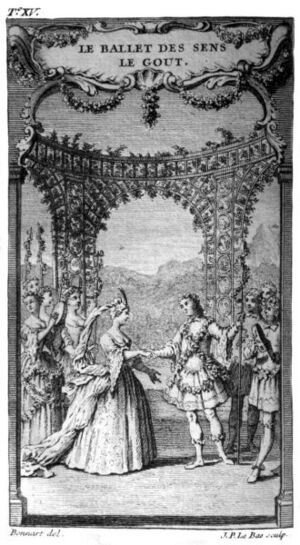Jean-Joseph Mouret facts for kids
Jean-Joseph Mouret (born April 11, 1682, in Avignon – died December 22, 1738, in Charenton-le-Pont) was a French composer. His exciting stage works made him a leading figure in Baroque music in France.
While most of his music is not often played today, Mouret's name is still famous. This is thanks to the popular Fanfare-Rondeau from his first Suite de symphonies. This piece is well-known as the theme song for the PBS show Masterpiece. It is also a popular choice for music at many modern weddings.
Life Story
Jean-Joseph Mouret was the son of Jean Bertrand Mouret, a silk merchant. His father made sure he received a good education. He also noticed Jean-Joseph's early talent for music and supported his choice to pursue it.
Mouret was a talented singer and began composing successfully. Around the age of 25, he moved to Paris. He was gifted and had a pleasant personality, which helped him become well-known quickly. In 1708, he met Anne, Duchess of Maine. Her home, the Sceaux, was a popular meeting place for important people during the later years of King Louis XIV's rule.
His friendly nature helped him gain the Duchess's support. She made him her Surintendant de la musique (music director) at Sceaux around 1708. At Sceaux, he created operas. He also managed 16 special bi-weekly events called Grandes nuits during the 1714–15 season. For these events, he produced short musical pieces and allegorical songs in the court masque style. He worked with the most favored musicians for the most important audience in France.
His opéra-ballet called Les fêtes, ou Le triomphe de Thalie ("Festivities, or The Triumph of Thalia") was first shown at the Opéra on August 19, 1714. The story's beginning showed the stage of the Opéra. In it, Thalia, the muse of Comedy, won over Melpomene, the muse of Tragedy. This idea caused a bit of a stir. So, the writer, Joseph de La Font, quickly created a new opening. It was called "La critique des fêtes de Thalie" and was shown on October 9.
In 1720, the title was changed to Les fêtes de Thalie. In 1722, a new part was added called "La provençale." This section featured regional costumes, instruments, and popular songs sung in the Provençal language. The 1722 version was much more accepted and became very popular. It continued to be performed until 1778.

In 1714, Mouret also became the director of the Opéra's orchestra. He held this job until 1718. From 1717 to 1737, he directed the Nouveau Théâtre Italien. For this theater, he composed short musical pieces called divertissements. These pieces went along with comedies by writers like Marivaux. These works were printed and filled six books.
At court, Mouret also worked as a singer. He directed large musical events for the Regent, the duc d'Orléans. These events took place at his château of Villers-Cotterêts in 1722. They celebrated King Louis XV becoming an adult. At the same time, Mouret directed a concert series called the Concert Spirituel (1728–1734). This series was started by the Opéra's orchestra. These positions gave his own music a public platform and allowed him to live comfortably.
Mouret married Madeleine Prompt de Saint-Marc in Versailles on October 23, 1711. They had one daughter, Françoise Louise, born in Paris on October 21, 1722. However, his later years were difficult due to money problems and social setbacks. Mouret faced tough times and health issues in his later years, passing away in 1738. The exact location of his grave is not known.
His Musical Works
Mouret mainly wrote music for the stage. He helped create unique French musical styles like lyric tragedy and opera-ballet. His later years were challenging, partly due to the growing fame of other composers like Jean-Philippe Rameau.
Some of his important stage works include:
- Les fêtes de Thalie (1714) – an opera-ballet for the Paris Opéra.
- Le mariage de Ragonde et de Colin (1714) – later known as Les amours de Ragonde.
- Ariane (1717)
- Pirithoüs (1723) – for the Paris Opéra.
- Les amours des dieux (1727) – for the Paris Opéra.
- Le triomphe des sens (1732)
- Les grâces héroïques (1733)
- Le temple de Gnide (1741) – for the Paris Opéra.
Mouret also wrote other types of music. These included airs (songs), divertissements (short musical pieces), cantatilles (small cantatas), motets (choral pieces), and instrumental works. His instrumental works included sonatas and fanfares.
Among his other compositions, two Suites de symphonies (1729) are very special. The first suite is famous for its opening rondeau, which is the Masterpiece Theatre theme song. It is called "Fanfare for trumpets, timpani, violins, and oboes." This suite was dedicated to the son of the Duchess of Maine, the Prince of Dombes. Mouret himself conducted the first performance of this suite at the Concert Spirituel.
The second suite was written for violins, oboes, and horns. It was first played at the Hôtel de Ville for King Louis XV.
See also
In Spanish: Jean-Joseph Mouret para niños

